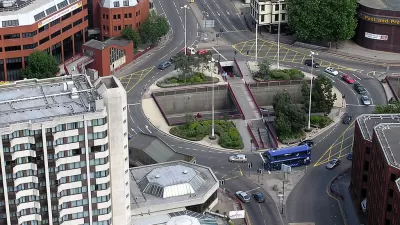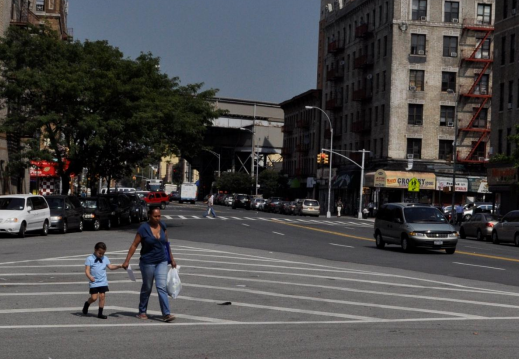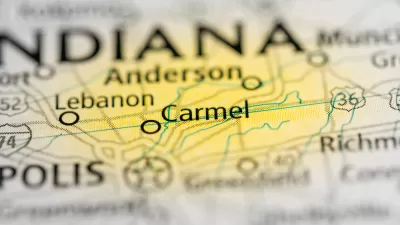Roundabouts, not to be confused with traffic circles, are becoming popular throughout the United States. The Bronx will get the first one in NYC. The insurance industry and FHWA consider them far safer than traffic lights and stop signs.

"Once seen only in countries like France and Britain, the roundabout, favored by traffic engineers because it cuts congestion and reduces collisions and deaths, is experiencing rapid growth in the United States," writes technology reporter Eric Taub. New York State has gone from 18 in 2005 to 112 today.
And New York City is getting its first one this month, when a three-way intersection in the Bronx that has been a challenge for pedestrians completes its conversion.
Before: Intervale Avenue at Dawson Street was an asphalt expanse where crossing distances are up to 200 feet. Photo: DOT [PDF] via Streetsblog NYC.
"The proposal is part of a larger road diet for Intervale Avenue in Longwood [PDF]," wrote Stephen Miller for Streetsblog NYC in February. "The plan was supported by a Bronx Community Board 2 committee in a 7-1 vote earlier this month."
The plan would convert Dawson Street from one-way to two-way and add “splitter islands” to both divide traffic as it approaches the roundabout and give refuge to pedestrians.
"Compared with stop signs and traffic lights, roundabouts are significantly safer, engineers say," writes Taub. "For example, crashes that result in serious injuries or death are reduced by 82 percent versus a two-way stop, and by 78 percent compared with an intersection with traffic lights, according to Jeff Shaw, the intersections program manager for the Federal Highway Administration."
According to Richard Retting, a former transportation researcher at the Insurance Institute for Highway Safety, "the reduction in injuries and fatalities was 'unmatched by anything else we can do in traffic engineering.'”
FULL STORY: As Americans Figure Out the Roundabout, It Spreads Across the U.S.

Alabama: Trump Terminates Settlements for Black Communities Harmed By Raw Sewage
Trump deemed the landmark civil rights agreement “illegal DEI and environmental justice policy.”

Planetizen Federal Action Tracker
A weekly monitor of how Trump’s orders and actions are impacting planners and planning in America.

The 120 Year Old Tiny Home Villages That Sheltered San Francisco’s Earthquake Refugees
More than a century ago, San Francisco mobilized to house thousands of residents displaced by the 1906 earthquake. Could their strategy offer a model for the present?

In Both Crashes and Crime, Public Transportation is Far Safer than Driving
Contrary to popular assumptions, public transportation has far lower crash and crime rates than automobile travel. For safer communities, improve and encourage transit travel.

Report: Zoning Reforms Should Complement Nashville’s Ambitious Transit Plan
Without reform, restrictive zoning codes will limit the impact of the city’s planned transit expansion and could exclude some of the residents who depend on transit the most.

Judge Orders Release of Frozen IRA, IIJA Funding
The decision is a victory for environmental groups who charged that freezing funds for critical infrastructure and disaster response programs caused “real and irreparable harm” to communities.
Urban Design for Planners 1: Software Tools
This six-course series explores essential urban design concepts using open source software and equips planners with the tools they need to participate fully in the urban design process.
Planning for Universal Design
Learn the tools for implementing Universal Design in planning regulations.
Clanton & Associates, Inc.
Jessamine County Fiscal Court
Institute for Housing and Urban Development Studies (IHS)
City of Grandview
Harvard GSD Executive Education
Toledo-Lucas County Plan Commissions
Salt Lake City
NYU Wagner Graduate School of Public Service






























